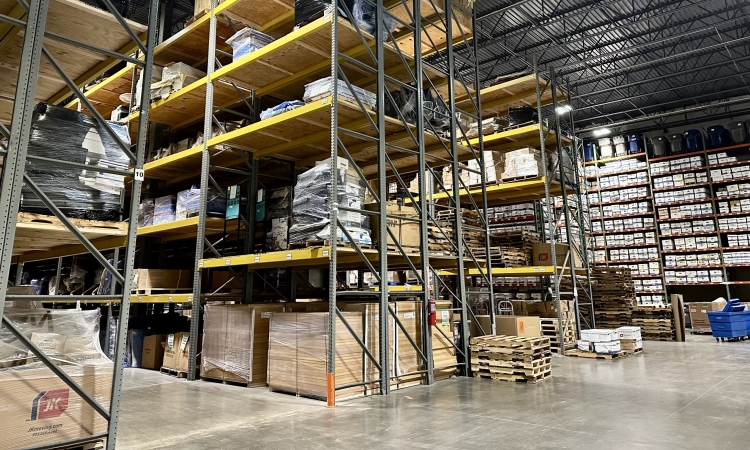Warehousing and storage serve as critical components of supply chain management. These services provide a centralized hub for the receipt, storage, and distribution of goods. Effective warehousing involves optimizing space utilization, effective inventory management systems, and timely order fulfillment.
Challenges often include inventory inaccuracies, poor space utilization, labor inefficiencies, and the need to adapt to dynamic market demands. Navigating warehouse asset management requires a strategic approach. It should integrate technology, process optimization, and a keen understanding of customer needs to deliver seamless operations and exceptional service.
What is an asset warehouse?
An asset warehouse is a centralized facility where various assets, ranging from physical goods to equipment and inventory, are stored, managed, and tracked. It serves as a vital component of supply chain logistics, ensuring the smooth flow of goods from production to distribution.
Efficient management within a warehouse is paramount since it directly impacts operational effectiveness, cost savings, and customer satisfaction. By utilizing technology and software solutions, a partner like JK Moving can help you streamline processes, improve inventory accuracy, and optimize resource utilization.
Asset tracking systems play a crucial role, enabling real-time visibility into the location and status of warehouse assets. Through best practices and resources, businesses can enhance their ability to meet customer demands, minimize losses, and drive operational excellence.
What is asset management in logistics?
Asset management in logistics combines the strategic handling, tracking, and maintenance throughout the supply chain, including inventory, equipment, and facilities. It plays a pivotal role in optimizing warehouse operations by ensuring efficient utilization of resources, minimizing downtime, and maximizing productivity. Central to this process is integrating technology and software solutions like warehouse management systems and data warehouse asset management platforms.
These tools provide real-time visibility into inventory levels, asset locations, and maintenance schedules, enabling warehouse managers to make informed decisions and streamline operations effectively. Incorporating asset management into logistical processes enables businesses to reap numerous benefits. Enhanced inventory asset management capabilities help organizations maintain optimal stock levels, reduce carrying costs, and mitigate stockouts.
Asset maintenance schedules can be automated. This ensures equipment remains in peak condition and minimizes the risk of breakdowns and associated disruptions. The seamless integration of asset management software with broader supply chain management systems facilitates smooth coordination across various logistical functions, from procurement to distribution.
Ultimately, the implementation of robust asset management practices empowers warehouse managers to enhance operational efficiency, improve customer satisfaction, and gain a competitive edge in today’s dynamic business landscape.
What does warehouse management do?
Warehouse management plays a crucial role in overseeing the efficient operation of a warehouse facility. This includes a range of responsibilities aimed at optimizing inventory flow and asset utilization. At its core, warehouse management involves the strategic planning, organization, and controlling of all warehouse activities, including inventory management, order fulfillment, and asset tracking.
Asset management within warehouse operations is particularly significant, as it ensures that resources are effectively allocated, maintained, and utilized. Integration of inventory and asset management systems enables seamless coordination between inventory levels and asset availability, facilitating accurate forecasting, timely replenishment, and improved decision-making.
Leveraging warehouse management systems and asset management software, businesses can enhance visibility into warehouse operations, streamline processes, and ultimately achieve greater operational efficiency and customer satisfaction in today’s competitive marketplace.
What is inventory management in a warehouse?
Inventory management in a warehouse is all about keeping track of and looking after all the goods that are stored in the warehouse. This includes getting items, putting them away, keeping track of where they are, and making sure they get sent out when they’re needed.
A big part of efficient inventory management is using technology to monitor where items are and make sure they’re in the right place. By doing this, businesses can avoid running out of goods, have less extra inventory, and deliver orders faster.
Good inventory management helps companies work better, saves them money, and makes their customers happier. It’s an important part of warehouse operations that helps keep everything running smoothly and contributes to the overall success of the business.
Common challenges in warehouse asset management
 Warehouse asset management presents challenges that businesses must address to maintain efficient operations. These challenges involve inaccuracies in asset tracking, suboptimal space utilization, labor inefficiencies, and adapting to evolving market demands. Implementing data warehouses for asset management introduces additional complexities, such as data integration and ensuring accuracy and consistency.
Warehouse asset management presents challenges that businesses must address to maintain efficient operations. These challenges involve inaccuracies in asset tracking, suboptimal space utilization, labor inefficiencies, and adapting to evolving market demands. Implementing data warehouses for asset management introduces additional complexities, such as data integration and ensuring accuracy and consistency.
To overcome these challenges, you need a comprehensive approach – one that integrates technology, process optimization, and employee training. Implementing robust asset and warehouse management systems, along with regular audits and performance evaluations, can help mitigate these challenges. Fostering a culture of continuous improvement and innovation empowers businesses to navigate warehouse asset management complexities effectively while staying agile and responsive to market dynamics.
The role of enterprise asset management
Managing the assets of a company is of utmost importance and extends beyond individual departments or locations. It involves strategic management of assets across various functions, closely aligned with the overall business strategy. Centralizing asset information and standardizing processes allows organizations to optimize resource utilization, minimize downtime, and extend the lifespan of critical assets.
Furthermore, EAM facilitates informed decision-making by providing comprehensive insights into asset performance, maintenance history, and compliance requirements. By maximizing benefits across the organization, EAM enhances operational efficiency and reduces costs. This ultimately strengthens the organization’s competitive advantage in today’s dynamic business landscape.
Conclusion
Managing your assets is important for making sure your logistics run smoothly, keeping costs low, and keeping your customers happy. As businesses face the challenges of running a warehouse, using efficient practices is key. Working with a warehouse asset management partner like JK Moving can help. Strong asset management systems, following best practices, and encouraging everyone to always improve can help your business enjoy major benefits and stay competitive in today’s fast-paced business world.


